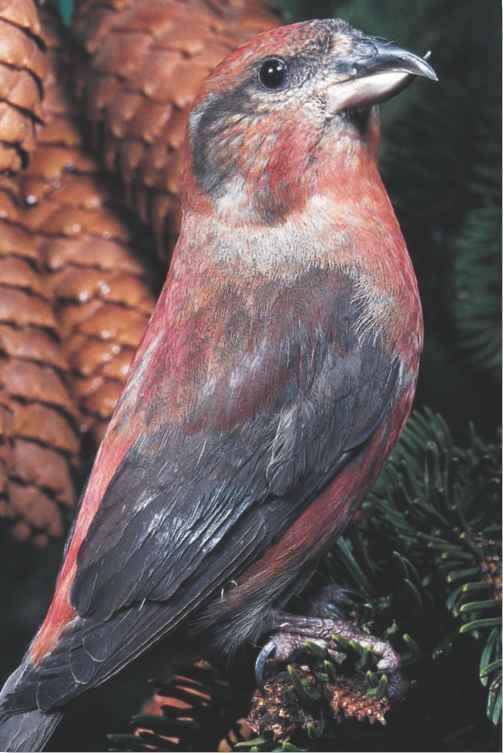ORDER
Passeriformes
FAMILY
Fringillidae
GENUS & SPECIES
KEY FEATURES
• Its extraordinary bill is-superbly adapted to removing seeds from Hi pine cones
• Risks breeding in the depths of winter so that its young will hatch in a period of plenty
• Leads a nomadic life, roaming over large areas of forest
• Occasionally leaves northern forests in flocks to find food
WHERE IN THE WORLD?
Found mainly in a broad band across northern parts of Eurasia and North America, with smaller, scattered populations in southern Europe, northwestern Africa and central Asia
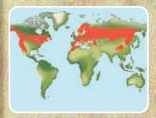
Lifecycle
The red crossbill pays a heavy price for its reliance on a single source of food: in the years when the pine cone crop fails, it must fly great distances or face starvation.
HABITAT
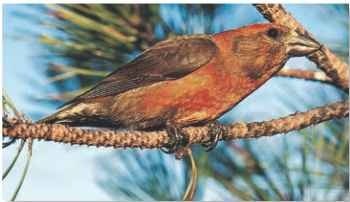
The largest red crossbill populations are in coniferous forests that extend from Scandinavia east to Siberia and in northern North America. Known as boreal forest, this densely wooded area is snowbound for half of the year, but it has a vast number of cone-bearing spruce and fir trees.
Farther south, the red crossbill is found in coniferous forests on the slopes of the Alps, Pyrenees, High Atlas and Rocky mountains and the Himalayas.
A Nordic invader After mass migrations from the forests of scandinavia in search of food, large colonies of red crossbills have expanded the species’ range in southern Europe.
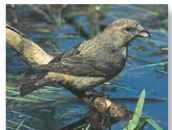
Scientists in Russia have calculated that a brood of red crossbills is fed an average of 90,000 seeds by its parents before fledging.
In autumn 1990, about 600,000 red crossbills appeared in eastern Britain, having fled Scandinavia and Russia in search of food.
BEHAVIOR
The nutritional quality of tree cones varies from year to year and area to area. This, combined with the fact that cones ripen at different times in different places, means that no single stretch of forest can support red crossbills all year Therefore, the bird must be constantly on the move. It travels in small flocks of up to 20, stopping wherever food is plentiful and then moving on when the supply is exhausted.
Every few years, when the cone crop fails, the red crossbill forms huge flocks that migrate southward in search of alternative food sources. Very large numbers of birds may die in these lean years.

FOOD & FEEDING
The red crossbill can appear parrotlike because it uses both its feet and its bill for climbing and feeding. Using this method to cling onto branches, the red crossbill can clamber foot-over-bill through the foliage and reach even the outermost cones.
While feeding, the red crossbill tends to hold cones steady with its feet while stripping them of seeds. Sometimes, it uses its bill to snip a cone from a stem before moving it to a new perch. The bird is often seen in small groups drinking from standing water on the forest floor: a diet of hard, dry seeds forces it to visit pools and streams several times a day to quench its thirst.
TWEEZERS IN THE TREE
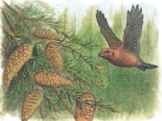
A welcome site…
After flying for miles, the red crossbill selects an area where the trees are laden with cones.
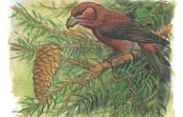
Branching out…
Clambering along a bough, the bird size up a plump cone, looking for the best angle of attack.
CONSERVATION
Red crossbill numbers vary ‘ greatly from year to year depending on food availability, but these fluctuations have little or no long-term effect on the species’ survival. In fact, as large areas in Britain, France, Belgium, Denmark and Germany have been turned over to conifer plantations over the course of the last 30 years, the redJ crossbill has extended its range.
Pine perch The red crossbill travels and feeds in small flocks.
BREEDING
Unlike most small birds of the Northern Hemisphere, the red crossbill’s breeding season starts early in the year This is because the cone seeds that it eats are most plentiful in midwinter. The female incubates her eggs for about two weeks, often in freezing temperatures. Despite her efforts and the nest’s lining of animal hair and grass, entire clutches may be destroyed by frost.
The young hatch just as pine cones are ripe and plentiful. They leave the nest after three to four weeks, but until their bills are fully formed, they are wholly dependent on their parents, both of which feed them a regular supply of regurgitaged conifer seed.
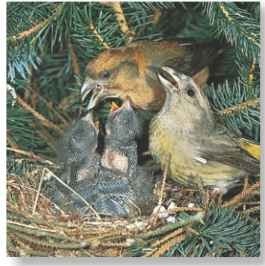
A Tools of the trade It takes six weeks for chicks’ bills to develop.

PROFILE
Red crossbill
The red crossbill’s strange-looking bill is a vital tool that allows the bird to take advantage of the one abundant food supply in its harsh habitat.
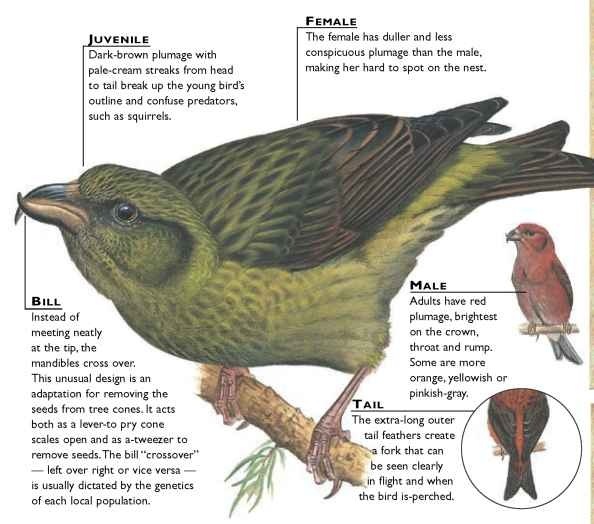
CREATURE COMPARISONS
The red crossbill has much in common with two other species of finch found in coniferous forests: the pine grosbeak (Pinicola enucleator) and the parrot crossbill (Loxia pytyopsittacus). All three species are strongly built for birds of their size, with a bull neck and stocky body. The males all have bold reddish plumage, contrasting with the drab females and gray-brown juveniles.The parrot crossbill is-a specialized feeder with a bill design like the red crossbill’s. The-pine grosbeak, which eats-shoots, leaves and berries, has a conventionally shaped but equally powerful bill.
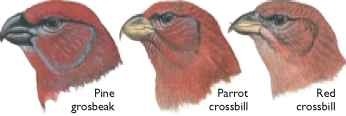
| VITAL | |
| STATISTICS | |
| Weight | 1.2-1.75 oz. |
| Length | 6.5″ |
| Wingspan | 11-12.5″ |
| Sexual Maturity | 6-12 months |
| Breeding Season | Almost year-round, peaking January-May |
| Number of Eggs | 2-5, usually 3-4 |
| Incubation Period | 14-15 days |
| Fledging Period | 20-25 days” |
| Breeding Interval | Usually 1 year |
| Typical Diet | Seeds of coniferous trees |
| Lifespan | At least 7 years |
RELATED SPECIES
• The 4 species of crossbill are the only members of the genus Loxia, which belongs to the finch family, Fringillidae. This family is divided into two subfamilies. Fringillinae contains the chaffinch, brambling and Canary Islands chaffinch. There are 120 or so species in the Carduelinae subfamily. All belong to the order Passeriformes, or perching birds.
